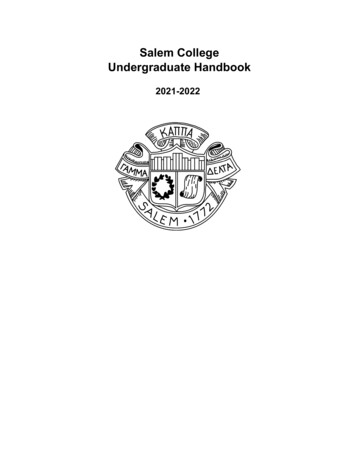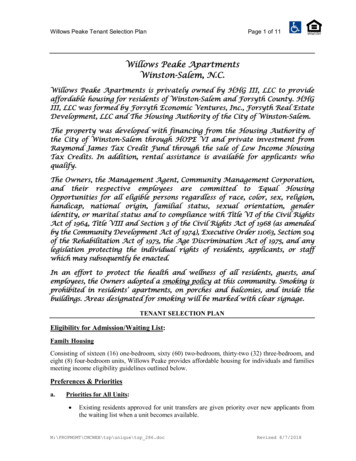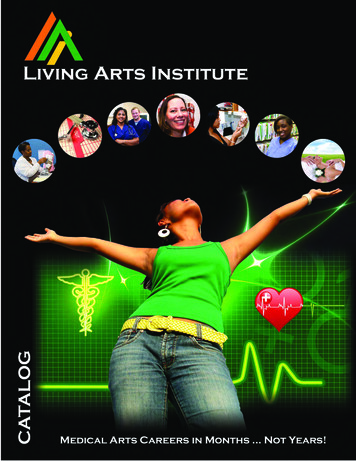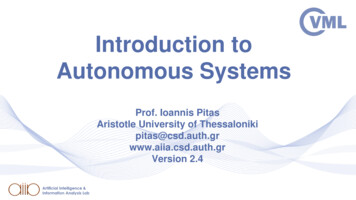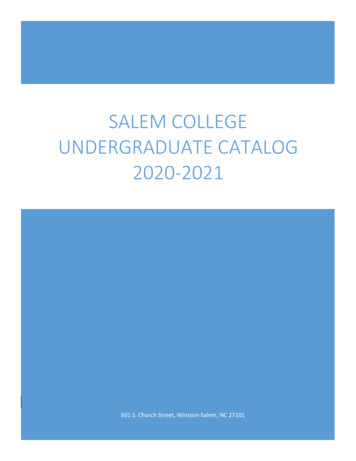
Transcription
GOVERNMENT ARTS COLLEGE (AUTONOMOUS), SALEM – 7NAAC ACCREDITED B STATUSAFFILIATED TO PERIYAR UNIVERSITY, SALEM – 11DEPARTMENT OF HUMAN RIGHTSM.A. HUMAN RIGHTSI & II YEARSYLLABUS & REGULATIONSI - IV SEMESTERS(FOR CANDIDATES ADMITTED FROM 2017-2018 UNDER CBCS PATTERN)
GOVERNMENT ARTS COLLEGE (AUTONOMOUS), SALEM – 7NAAC ACCREDITED B STATUSAFFILIATED TO PERIYAR UNIVERSITY, SALEM – 11M.A. HUMAN RIGHTS(FOR CANDIDATES ADMITTED FROM 2017-2018 UNDER CBCS PATTERN)1. CONDITION FOR ADMISSIONA candidate who has passed any U.G Degree from this autonomous collegeor any of the above degree of any other university accepted by the academiccouncil as equivalent there to, subject to such a condition as may be prescribedthere to are permitted to appear and qualify for them. M.A., Degree Examinationsof this autonomous college after a course of study of two academic years.2. DURATION OF THE COURSEThe course of Master of Arts in Human Rights shall consists of twoacademic years divided into four semesters.3. COURSE OF STUDYThe course of study comprise instruction in the following subjectsaccording to the syllabus and books prescribed from time to timeSEMESTER – I1. Core Course – I- Foundation of Human Rights2. Core Course – II- Development of Human Rights3. Core Course – III- Human Rights and Duties under IndianConstitution4. Core Course – IV- Human Rights Movements in India5. Elective Course – I- Principles of Humanism and its Perspectives
SEMESTER – II6. Core Course – V- Criminal Justice Administration and Human Rights7. Core Course – VI- Human Rights Advocacy and Redressal ofGrievances8. Core Course – VII- Contemporary Issues of Human Rights9. Core Course – VIII- Group Rights10. Non-Major Elective-I-Environmental RightsSEMESTER – III11. Core Course – IX- Science, Technology and Human Rights12. Core Course – X- Defending Women’s Rights13. Core Course – XI- Research Methodology14. Elective Course – II- Media and Human Rights15. Non-major Elective- General Studies for competitive ExaminationsSEMESTER – IV16. Core Course – XII- Cyber Issues and Human Rights17. Core Course – XIII- Intellectual Property Rights18. Core Course – XIV- Biomedical Ethics and Human Rights19. Project- Project and viva voce4. EXAMINATIONThe theory Examination shall be of 3 Hours duration to each paper at theend of each semester. The candidate failed in any subject will be permitted toappear for each failed subject or subjects in the subsequent ExaminationsThe Examination consist of INTERNAL ASSESSMENT (I.A) and SemesterExamination (S.E)Internal assessment marks for theory papers are as follows55510 25At the end of fourth semester Viva-voce will be conducted on the basis ofthe dissertation / project report submitted by the studentThe Viva-voce will be conducted by one internal and one external examinerjointly
5. SCHEME OF EXAMINATIONSThe scheme of Examinations for different semesters shall be as followsSemesterICore/Elective/Supportive PaperCore - ITitle of the PaperDurationIASEFoundations of HumanRightsDevelopment of HumanRightsHuman Rights and Dutiesunder Indian ConstitutionHuman Rights Movementsin IndiaPrinciples of Humanismand its PerspectivesCriminal JusticeAdministration andHuman RightsHuman Rights Advocacyand Redressal ofGrievancesContemporary Issues ofHuman RightsGroup RightsEnvironmental Rights3 Hrs2575TotalMarks1003 Hrs25751003 Hrs25751003 Hrs25751003 Hrs25751003 Hrs25751003 Hrs25751003 Hrs25751003 Hrs3 Hrs25257575100100Science, Technology andHuman RightsCore - XDefending Women’sRightsCore - XIResearch MethodologyElective Course - IIMedia and Human RightsNon-major Elective - II General Studies forCompetitive ExaminationsCore – XIICyber Issues and HumanRightsCore – XIIIIntellectual PropertyRightsCore – XIVBiomedical Ethics andHuman RightsProject WorkProject and viva voce3 Hrs25751003 Hrs25751003 Hrs3 Hrs3 Hrs2525257575751001001003 Hrs25751003 Hrs25751003 Hrs2575100100100200Core - IICore - IIICore - IVElective Course - IIICore - VCore - VICore - VIICore - VIIINon-major Elective - IIIIIVCore - IX
SEMESTERCCXGOVERNMENT ARTS COLLEGE (AUTONOMOUS), SALEM – 7M.A. DEGREE IN HUMAN RIGHTSCOURSE STRUCTURE UNDER CBCS PATTERNCOURSESTUDYHR/PAPER TITLECRECODECOMPONENTSWEEKFoundations of17PHR01CORE COURSE-I64Human RightsDevelopment of17PHR02CORE COURSE-II64Human RightsHuman Rights andDuties underCORE COURSE-III17PHR0364IndianConstitutionHuman RightsCORE COURSE-IV Movements in17PHR0464IndiaPrinciple ofELECTIVE17PHRM1Humanism and its64COURSE-IperspectivesCriminal Justice17PHR05CORE COURSE-V Administration65and Human RightsHuman RightsAdvocacy andCORE COURSE-VI17PHR0664Redressal ofGrievancesContemporaryCORE COURSE-VII Issues of Human17PHR0765RightsCORE COURSE-VIII Group Rights17PHR0865EnvironmentalNON MAJORRights17PHRN1ELECTIVE63COURSE-1Science,CORE COURSE-IX Technology and17PHR0965Human RightsDefending17PHR10CORE COURSE-X Women’s 7PHR12CORE COURSE-XIICCXIII17PHR13CORE COURSE-XIIIXXIV17PHR14CORE CVCCVIIICCVIICCVIIINME-ICCIXIIICORE COURSE-XIELECTIVECOURSE-IINON MAJORELECTIVECOURSE-IIIVTotalMARKSIA ethodology652575100Media and 5751006 610200120902000General Studiesfor CompetitiveExaminationsCyber Issues andHuman RightsIntellectualProperty RightsBiomedical Ethicsand Human RightsDissertation &Viva voce
Government Arts College (Autonomous), Salem – 7M.A (Human Rights) SyllabusFirst SemesterPaper 1Course Code: 17PHR01Foundations of Human RightsUnit – IDefinition, scope and Concept of Human Rights – Classification of Rights – Natural,Moral and Legal RightsUnit – IIEvolution of Human Rights - Magnacarta – United States Declaration ofIndependence – French Declaration of Rights of man and citizen – Universal Declaration ofHuman Rights 1948Unit – IIIInternational Covenant on Civil and Political Rights, International Covenant onEconomic, Social and Cultural RightsUnit – IVHistorical Perspective of human Rights – Raj neethi, Lok neethi, Danda neethi –Nyaya, Dharma;Unit – VTheories of Human Rights – Natural Rights, Social Rights, Legal Rights, HistoricalRighhts, Economoc RightsReading List:1. Amartya Sen, The Idea Justice, New Delhi: Penguin Books, 20092. Conor Greaty and Adam Tomkins (Eds). Understanding Human Rights, London: Manshell,19963. David Beetham Politics and Human Rights, Oxford: Blackwell, 19954. Gurpreet Mahajan Ed., Domocracy, Difference and Social Justice, New Delhi: OxfordUniversity Press, 19985. James Nickel, Making Sense of Human Rights: Philosophical Reflections on the UniversalDeclaration of Human Rights, Berkeley: University of California Press, 20016. John Rawls, Law of People, Cambridge: Harvard University Press, 20017. Michael Freedan, Rights, Delhi: World view 1988 (Indian Report)8. Michael Rreedan, Human Rights: Interdisciplinary approach, Oxford: Polity, 20029. R.J.Vincent, Human Rights and International Relations, Cambridge: Cambridge UniversityPress, 198610. Ronald Dworkin, taking Rights Seriously, London: Duckworth, 197811. Stephen Shute and Susal Herley (Eds), on Human Rights, New York: Basic Books, 199312. Waldron, Jeremy, Theories of Rights, Oxford University Press, 198413. Will Kymlicka (Eds), Rights of Minority Cultures, Oxford University Press, 199514. Upendra Baxi: The Future of Human Rights, New Delhi, Oxford University Press
Government Arts College (Autonomous), Salem – 7M.A (Human Rights) SyllabusFirst SemesterPaper 2Course Code: 17PHR02Development of Human RightsUnit – IDevelopment of Human Rights and Origin of United Nations OrganisationUnit – IIStructure and Function of United Nations OrganisationUnit – IIIDevelopment of Human rights in India – National Human Rights Commission, StateHuman Rights Commission, National Commission for SC/St, Women and ChildrenUnit – IVConsumer Protection Right, Right to Information and Right to dissentUnit – VUniversal Suffrage Movement – Right to voteReading List:1. S.N. Chaudhary, Human Rights and Poverty in India: Theoretical issues, Delhi: Concepts,20052. Anuradha Kumar, Encyclopedia of Human Rights Development of under Privilege, NewDelhi: Sarup, 20023. M.H.Syed, Human Rights in Islam: the Modern Perspective, New Delhi: Anmol, 20034. Mathur, Crime, Human Rights and National Security, New Delhi:Gyan Pub.5. P.M.Katare and B.C.Barik, Development, Deprivation and Human Rights Violation, NewDelhi:Rawat, 20026. Mujawar, Wasiyoddin R., Social and Political Movements for Human Rights, Delhi:Mangalam Pub., 20097. Subramaniyan, K.S., Political violence and the police in India, Los Angel: Sage, 20078. B.Goswami, Human Rights and reforming the Law: a compendium of Articles of HumanRights and Legal Reforms, Jaipur: Raj Pub., 20089. P.Madhava & Soma Sundaram, K.Jaishankar, Crime Victims and Justice: an Introductionto restorative principles, New Delhi: Serials Publications, 200810. James Vadackumchery, Policing the Police: a Nation’s Cry, New Delhi: Kaveri Books,200311. Paras Diwan & Peeyushi Diwan, Human Rights and the Law: Universal and Indian, NewDelhi: Deep & Deep, 199812. Venkat Iyer (ed), Democracy, Human Rights and the Rule of Law: Essays in Honour ofNani Palkhivala, New Delhi: Butterworths, 2002
Government Arts College (Autonomous), Salem – 7M.A (Human Rights) SyllabusFirst SemesterPaper 3Course Code: 17PHR03Human Rights and Duties under Indian ConstitutionUnit – IConstitution of India - PreambleUnit – IIFundamental rights – Part III of Indian ConstitutionUnit – IIIFundamental Duties ; Directive Principles of State PolicyUnit – IVRedressal mechanisms in Indian Constitution - WritsUnit – VEmergency Provisions in Indian ConstitutionReading List:1. G.S. Pande - Constitutional Law of India, Allahabad Law Agency, Eighth Edition,2002.2. J.N. Pandey - Constitutional Law of India, Central Law Agency, Allahabad, 20033. M.P. Jain- Indian Constitutional Law, Nagpur Wadhwa, 2003, 2 Volumes4. Krishna Gupta - Social Equality And The Indian Constitution5. P.L. Mehata, NeenaVerma - Human Rights Under The Indian Constitution
Government Arts College (Autonomous), Salem – 7M.A (Human Rights) SyllabusFirst SemesterPaper 4Course Code: 17PHR04Human Rights Movements in IndiaUnit – IThe Evolution, Importance Functions and Strategies of Human Rights Movement inIndiaUnit – IIPolitical, Social and Religious Reforms – Agrarian and Peasant Movement BackwardClass, Dalits and Women Movements – Ecological and Environment MovementsUnit – IIINGOs in India: Structure – Functions and Problems, Land, Water and Forest Issuesand Human Rights Movements – People’s Watch, Civil and Democratic Organization inIndiaUnit – IVAnti-Colonial Movements – Non-violent – Freedom Movement - Anti-nuclearMovements in IndiaUnit – VHuman Rights Education – Problems and Prospects – New Social Movements,Democratic Struggles and Human RightsReading List:1.2.3.4.5.6.7.8.9.10.11.12.13.B.P.Singh, Human Rights in India: Problems and Perspecties, New Delhi: Deep & Deep, 2008Aftab Alam, Human Rights in India : Issues and Challenges, Delhi: Raj Publications, 2004Shanker Sen, Tryst with Law Enforcement and Human Rights: four decandes in Indian Police,New Delhi: APH, 2009Harsh Bhanwar, Human Rights Law in India: Protection and Implementation of the Human Rights,New Delhi: Regal Pub., 2008Jaiswal Jaishree, Human Rights of accused andjuveniles: Delinquent in conflict and Law, Delhi:Kalpaz: 2005L.K.Thakur, Essentials of POTO and other Human Rights Laws, New Delhi: Author Press, 2002Awasthi, S.K.& R.P.Kataria, Law Relating to Protection of Human Right, New Delhi: OrientPublishing, 2002South Asia Human Rights Documentation Centre (SAHRDC), Handbook of Human RightsandCriminal Justice in India: the System and Procedure, New Delhi: OUP, 2006Noorjahan Bava, Human Rights and Criminal Justice Administration in India, New Delhi: Uppal,2000K.P.Sanksena (ed.), Human Rights and the Constitution: Vision and the Reality, New Delhi: GyanPublishing, 2003Upendra Baxi: The Future of Human Rights, New Delhi: Oxford University PressStephen Shute and Susan Herley (eds.), On Human Rights, New Tirj: Basic Books, 1993SAHRDC, Human Rights and Humanitarian Law, New Delhi:South Asian Human RightsDocumentation Centre, 2002
Government Arts College (Autonomous), Salem – 7M.A (Human Rights) SyllabusFirst SemesterPaper 5Course Code: 17PHRM1ELECTIVE COURSEPrinciples of Humanism and its perspectivesUnit – IConcept of Humanism – Duties and Responsibilities. Human Values and ethicsUnit – IIDuties towards Self, Family, Community, Society and Nation. Humanitarian concernstowards other beings and Mother EarthUnit – IIIInterdependence of peace, development and securityUnit – IVAreas of Harmony and Conflicts – Techniques of Conflict ResolutionUnit – VHumanistic perspectives in Gandhian thoughts, Dr. Ambedhkar’s Principles, DalaiLama’s teachings and Martin Luther King’s speechesReading List:1. Kaushuk Vijay, Women Movement and Human Rights Jaipur Pomta Publications –19992. Kumar, Arvind, Human Rights and Social Movements, 19993. K.P.Sanksena (ed.), Human Rights and the Constitution: Vision and the Reality, NewDelhi: Gyan Publishing, 20034. Upendra Baxi: The Future of Human Rights, New Delhi: Oxford University Press5. Stephen Shute and Susan Herley (eds.), On Human Rights, New Tirj: Basic Books,19936. SAHRDC, Human Rights and Humanitarian Law, New Delhi:South Asian HumanRights Documentation Centre, 2002
Government Arts College (Autonomous), Salem – 7M.A (Human Rights) SyllabusSecond SemesterPaper 1Course Code: 17PHR05Criminal Justice Administration and Human RightsUNIT I :Components of Criminal Justice System & their relevance to Human Rights; Juvenile Justice System–United Nations Standard Minimum Rules for Administration of Juvenile JusticeUNIT II :Law enforcement organizations and human rights violations – Practices and procedures in violationsto human rights with emphasis to arrest, search and seizure; Investigation and interrogation,handcuffing, Encounters, custodial deaths and torture; Rights of the arrested and accusedUNIT III:Judicial activism and review, PIL, Access to justice, concept of fair trial and fair treatmentUNIT IV :Human rights and correctional administration – Rights of prisoners – United Nations StandardMinimum Rules for the Treatment of Prisoners, Preventive detentions and under trialsUNIT V :Rights of victims of human rights violations, United Nations Declaration on the Basic Principles ofJustice to Victims of Crime and Abuse of Power, 1985; Victim service and victim assistanceprograms – Social support, Coping skills and vulnerability analysis.Reading List:1. Dennis Sullivan,Handbook of Restorative Justice: A Global Perspective, Berlin, 20022. K. Chockalingam, Readings In Victimology, Raviraj Publications, 19963. K.M. MathurCrime, Human Rights and National Security. 1996,4. Peter Birks, Reshaping The Criminal Justice & Human Rights, 19955. R Thilagaraj,Human Rights & Criminal Justice Admn, ManoharPbs, N.Delhi, 2000
Government Arts College (Autonomous), Salem – 7M.A (Human Rights) SyllabusSecond SemesterPaper 2Course Code: 17PHR06Human Rights Advocacy and Redressal of GrievancesUNIT IPublic Advocacy – Role of Awareness Campaigns in Safeguarding Human RightsUNIT IIRedress Mechanism under the UN – Human Rights Council. International criminalcourtUNIT IIIAdvocacy at the National level in India – Factors that led to the passing of Protectionof Human Rights Act 1993 – Functions of NHRC, SHRC in grievance redressal andLokAdalats.UNIT IVTamil Nadu State Legal Services Authority and its role. Public hearing.Ombudsman,National Confederation of Human Rights organisationsUNIT VGeneral Difficulties in the implementation and redress of Human Rights ViolationsReading list:1. Anuradha Kumar, Human Rights: Global Perspective, Sarup& Sons, New Delhi, 20022. Philip Alston(Ed), The United Nations And Human Rights: A Critical Appraisal,Oxford University Press, New York, 19923. Dr. S. Mehartaj Begum(Ed), Human Rights In India: Issues And Perspectives, APHPublishing Corporation, New Delhi, 20004. D.J. Ravindran, Human Rights Praxis: A Resource Book For Study, Action AndReflection, Earth Worm Books, Chennai, 1998
Government Arts College (Autonomous), Salem – 7M.A (Human Rights) SyllabusSecond SemesterPaper 3Course Code: 17PHR07Contemporary Issues of Human RightsUNIT IIntroduction to contemporary issues- Discrimination – Casteism, racism, communalism –Honour killingUNIT IIIssue of Special Economic Zones with reference to displacement of disadvantaged sections ofthe society – issues faced by indigenous people.UNIT IIICorporate Social Responsibility- Corruption – consumer exploitation; off shoring and braindrainUNIT IVRight to Health, Addiction to Alcoholism and Drugs - HIV / AIDS and Human rights – lackof access to public health care.UNIT VTerrorism and Human Rights– Origin and Development – causes – types - CombatingTerrorism – Media and Terrorism.Reading list:1.Fred Ramen. The Rights of the Accused, The Rosen Publishing Group, 20012.R K Narasimhan , Human Rights and Social Justice Ajay Verna for CommonwealthPublishers, 19993.Alan B Mountjag, The Third World Problem and Perspectives4.Chitkara M G Gird Hari Sharma. International Terrorism5.ParmanandParashan,Terrorism Worldwide Indo – US Perspectives,Sarup&Sons,NewDelhi, 2002
Government Arts College (Autonomous), Salem – 7M.A (Human Rights) SyllabusSecond SemesterPaper 4Course Code: 17PHR08Group RightsUNIT IGroup rights – Individual Vs. Collective Rights – Rights of Women – Conventionon the Elimination of Discrimination Against Women (CEDAW) Crimes againstwomen – Female Genital Mutilation, Domestic violence, Dowry, Rape, EveTeasing, Sexual Harassment, Molestation, Pornography, female infanticide.UNIT IIRights of Children - Convention on the Rights of The Child, 1989 – violation ofchild rights - Child Abuse, Child labour, Corporal punishments in schools –Street Children.UNIT IIIRights of the disabled - Persons With Disabilities (Equal Opportunities,Protection of Rights and Full Participation) Act 1995; violations of the rights ofdisabled – Affirmative action.UNIT IVRights of Minorities – Provision in International Bill of Rights and IndianConstitution. - Marginalized Groups, Indigenous People’s Cultural Rights - SelfDetermination.UNIT VRights of Migrant Workers – UN Convention on protection of Migrant Workersand their family members - ILO Conventions; 1951; Rights of Refugees andStateless people -Convention on The Status of RefugeesReading List:1. Anuradha Kumar, Human Rights: Global Perspective, Sarup& Sons, New Delhi2. Philip Alston(Ed), The United Nations And Human Rights: A Critical Appraisal,Oxford University Press, New York, 19923. Dr. S. Mehartaj Begum(Ed), Human Rights In India: Issues And Perspectives, APHPublishing Corporation, New Delhi, 20004. D.J. Ravindran, Human Rights Praxis: A Resource Book For Study, Action AndReflection, Earth Worm Books, Chennai, 1998
Government Arts College (Autonomous), Salem – 7M.A (Human Rights) SyllabusSecond SemesterPaper 5Course Code: 17PHRN1Environmental RightsUnit – IDefinition of Environment as Human Right; Salient features of The Environment (Protection)Act, 1986,Unit – IIEnvironmental Impact Assessment, Eco-labeling, environmental racism, ecocide (the plannedand purposeful destruction of the environment), and the victimization of those supportingenvironmental rights.Unit – IIIOzone depletion and Global Warming, Issues of Industrial Pollution, Prevention,Rehabilitation;Safety of Nuclear TechnologiesUnit – IVMain functions of United Nations Environment Program – right to development vs right toclean environment, climate change, major environment disasters and conflicts.Unit – VPrecautionary Principle and the Polluter pays principle, public trust doctrine, commonheritage principle Strict liability, Role of Public Interest Litigation in environmentalprotection in India; ecojustice, Green bench, Environmental governance and ecosystemmanagement.Reading List:1. Therese Murphy (ed), New Technologies and Human Rights, OUP, Clarendon, 20092. Roger Brownsword, Rights, Regulation and the Technological revolution, OUP,Clarendon, 20093. Ruth Deech and Anna Smajdor, Form IVF to Immortality: controversy in the Era ofReproductive Technology, OUP, Clarendon, 20094. R.J. Cook and C.G.NGwena (eds), Health Human Rights, OUP, Clarendon, 20075. G.Hodge el al (eds), New Global Frontiers of regulation: The age of Nanotechnology,OUP, Clarendon, 20076. H.Somsen (ed) , The regulatory challenge of Biotechnology: Human Genetics, Food andPatents, OUP, Clarendon, 20077. UNESCO, Ethics of Science and Technology: Explorations of the Frontiers of scienceand ethics, OUP, Clarendon, 20068. Rogar Brownsword (ed), Human Rights OUP, Clarendon, 20049. A Plomer, The Law and Ethics of Medical Research: International Bioethics and Humanrights, OUP, Clarendon, 200510. A Murray (ed), Human Rights in the Digital Age, OUP, Clarendon, 200511. F.Francioni (ed), Biotechnology and International Human Rights, OUP, Clarendon, 200712. Nuffield Council on Bioethics, Genetically modified Crops: The Ethical and SocialIssues, OUP, London, 199913. Roger Brownsword and K Yeung (eds), Regulating Technologies, OUP, Clarendon, 200814. F.Francioni (ed), The impact of Technologies on Human Rights, OUP, Clarendon, 2008
Government Arts College (Autonomous), Salem – 7M.A (Human Rights) SyllabusThird SemesterPaper 1Course Code: 17PHR09Science, Technology and Human RightsUnit – INegative role of Science and Technology on Sustainable Development – Careless useof Natural Resources – Inter generational equity.Unit – IIBio-Technology and Human Rights – Human Cloning, Foeticide, SurrogateParenthood, In – Vitro Fertilization; Right to Die in Dignity – EuthanasiaUnit – IIIIssues on developments in Science and Technology – Human Cloning – OrganTransplantation and sale of human organs – Human experimentation in use of pharmaceuticalproducts.Unit – IVNational and International Obligations and Laws – Rio and Kyoto Declarations –Measures taken in India and CanadaUnit – VForest Depletion and Pollution of River System (Culprits and Victims) – HazardousWaste and Discarded Technological InstrumentsReading List:1.2.3.4.5.6.7.8.9.10.11.12.13.14.15.Therese Murphy (ed.), New Technologies and Human Rights, OUP, Clarendon, 2009.Roger Brownsword, Rights, Regulation and the Technological Revolution, OUP, Clarendon, 2009.Ruth Deech and Anna Smajdor, Form IVF to Immortality: Controversy in the Era of ReproductiveTechnology, OUP, Clarendon, 2009R.J.Cook and C.G,Ngwena (eds.), Helth and Human Rights, OUP, Clarendon, 2007G.Hodge el al (eds.), New Global Frontiers of Regulations: The Age of Nanotechnology, OUP,Clarendon, 2007.H.Somsen (ed.), The Regulatory Challenge of Biotechnology: Human Genetics, Food and Patents,OUP, Clarendon, 2007UNESCO, Ethics of Science and Technology: Explorations of the Frontiers of Science and Ethics,OUP, Clarendon, 2006Roger Brownsword (ed.), Human Rights, OUP, Clarendon, 2004A Plomer, The Law and Ethics of Medical Research: International Bio-ethics and Human Rights,OUP, Clarendon, 2005A Murray (ed.) Human Rights in the Digital Age, OUP, Clarendon, 2005F.Francioni (ed.), Bio-technology and International Human Rights, OUP, Clarendon, 2007Nuffield Council on Bio-ethics, Genetically Modified Crops: The Ethical and Social Issues, OUP,London, 1999Roger Brownsword and K.Yeung (eds.) Regulating Technologies, OUp, Clarendon, 20083F.Francioni (ed.), The Impact of Technologies on Human Rights, OUP, Clarendon, 2006C.G.Weeramantry, Justice without Frontiers: Protecting Human Rights in the Age of Technology,OUP, Clarendon, 1997
Government Arts College (Autonomous), Salem – 7M.A (Human Rights) SyllabusThird SemesterPaper 2Course Code: 17PHR10Defending Women’s RightsUnit – IWomen rights – Gender violence throughout the life cycle; Sexual harassment at thework place – Duty of the employer – Visaka guidelines.10hrsUnit – IISexual offences - Legal remedies under IPC for Rape, Molestation, Assault with intent tooutrage the modesty of women.Unit – IIIRights related to marriage – Steps to be followed for a marriage (As per the Hindu, Muslim,Christian law and the Special Marriage Act) – Reproductive rights – legal effect of bigamy &adultery - Divorce and Maintenance.Unit – IVDomestic violence – The Protection of Women from Domestic Violence Act, 2005; Conceptof Dowry- Permissible gifts, Salient features of Dowry Prohibition Act, 1962.Unit – VWomen’s right to property, Succession and inheritance – women’s right to nationality- rightto participate in governance.Reading list1. Protection of Women from Domestic Violence Act, 20052. Hindu Adoption and maintenance Act3. Family law in India, Subbarao. G.C.V (2001), S. Gogia and Co., Hyderabad4. Breaking Barriers : Stories of Twelve Women/Parvathi Menon. Reprint. NewDelhi, Left Word Books, 2005, Ix, 150 P.,5. Caste, Marriage and Inequality: Essays on North and South India/PaulineKolenda. New Delhi, Rawat, 20036. Changing Family Roles and Feminism/Edited By Man Singh Das and VijayKumar Gupta. 19967. Changing Status of Women in India/Sangeeta Nagaich. 19978. Globalization, Culture and Women's Development/Edited By Raj MohiniSethi.1999
Government Arts College (Autonomous), Salem – 7M.A (Human Rights) SyllabusThird SemesterPaper 3Course Code: 17PHR11Research MethodologyUnit INature and definition of research; Human rights as an object of inquiry; Selecting a researchproblem; literature review; Framing a research proposalUnit IIVariables, Objectives, Research questions and Hypothesis; Research methods - descriptive,analytical, comparative, case study.Unit IIIData collection: types of data, methods of data collection - observation, interview; Researchtools - questionnaires, schedules and scales; Sampling: probability - simple random,systematic, stratified, multi stage; Non probability - snowball, purposive;Unit IVPilot study; reliability and validity; Data analysis using SPSS, interpretation of results,quantitative and qualitative analysisUnit VReport writing, documentation, chapterization, references, Problems, Ethics andConfidentiality in human rights research,.Reading list:1. Babbie, E. (2011). Adventures in social research: Data analysis using IBM SPSSstatistics (7th ed.). Los Angeles, California: Pine Forge Press.2. Gibaldi, Joseph. (1988). A handbook for writers of research papers. New York:Modern Language Association of America.3. Gilbert, N. (Ed.) (2001). Researching social life. London: SAGE.4. Kothari, C. R. (1996). Research methodology: Methods & techniques (2nd ed.). NewDelhi: Wiley Eastern.5. Silverman, D. (2004). Qualitative research. London: SAGE.6. Young, Pauline V. (1966). Scientific social surveys & research (4th ed.). EnglewoodCliffs, NJ: Prentice Hall
Government Arts College (Autonomous), Salem – 7M.A (Human Rights) SyllabusThird SemesterPaper 4Course Code: 17PHRM2Media and Human RightsUnit – IMedia –Definition-Various forms of media – Print, Electronic (Broadcast), Art media – radio,television, internetUnit – IIReporting – Downsizing, dumbing down and ‘infotaining’ – Types of reporting - The cultureof breaking news – Impact of bias, propaganda and distortion, evaluating sources, protectingconfidentiality of sources, interviewing experts and victims.Unit – IIIMedia ethics and the issues in handling sources – meaning of defamation, libel and slander,Yellow journalism, Women and Media- Content, Portrayal and AccessUnit – IVDuties of media, social responsibility- paid news, conspiracy of silence; Intersection of mediaand human rights, Human rights organizations and media regimesUnit – VReportwriting – Techniques and styles of writing for various types of media, editing, andconcise writing – Presentation of reports - Impact of Investigative journalism on human rightsissues.Reading list:1.2.3.4.5.6.7.8.9.10.11.12.13.14.Arnett, Peter. “Goodbye World — Why Foreign News is Vanishing from America’sNewspapers”, American Journalism Review, November 1998, pp. 50-67.Bagdikian, Ben H. The Media Monopoly. Boston: Beacon Press, 1983 and 1997 editions.Burnheim, Sally. The Right to Communicate — The Internet in Africa. London: Article 19, 1999.Casmir, Fred, ed. Communications in Eastern Europe — The Role of History, Culture, and Mediain Contemporary Conflicts. Mahwah: Lawrence Erlbaum Associates, 1995.Cohen, Stanley. Denial and Acknowledgement: The Impact of Information about Human RightsViolations. Jerusalem: Centre for Human Rights, the Hebrew University of Jerusalem, 1995.Comor, Edward A. “Governance and the ‘Commodisation’ of Information”, Global Governance 4,2, April-June 1998, pp. 217-233Stanley Cohen, Denial and Acknowledgement: The impact of information about Human Rightsviolations, Jerusalem, 1995Human Rights violations: Communicating the information, London: index on Censorship, 1995Kayoko Mizuta, “Human Rights and the Media, in Asian media information and communicationcentre, Media and Human Rights in Asia, Singapore: AMIC, 2000Deneen L. Brown, “Journalists Feel Shackled by New Owner”, The international Herald Tribune,2002John Keane, The Media and Democracy, Cambridge: Policy Press, 1991John Naughton, “With the Rusty Sword of Touth Television’s influence and the systemic crisis inserious Journalism”, Times Literary Supplement, 1998Douglas Farah, “Death of a crusading Journalist puts pressure on Burkina Faso president”, TheWashington post, 2000
Government Arts College (Autonomous), Salem – 7M.A (Human Rights) SyllabusThird SemesterPaper 5Course Code: 17PGN02General Studies for Competitive ExaminationsUNIT-I: INDIAN POLITYFeatures of Indian Constitution - Directive principles of state policy - President –Parliament – Judiciary - Centre-state relations - State administration – Panchayat Raj.UNIT-II : MODERN HISTORYEmergence of Indian Nationalism -
NAAC ACCREDITED B STATUS AFFILIATED TO PERIYAR UNIVERSITY, SALEM - 11 M.A. HUMAN RIGHTS (FOR CANDIDATES ADMITTED FROM 2017-2018 UNDER CBCS PATTERN) 1. CONDITION FOR ADMISSION A candidate who has passed any U.G Degree from this autonomous college or any of the above degree of any other university accepted by the academic

